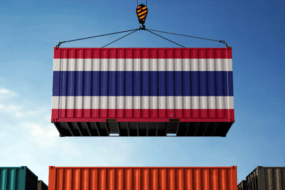- Home
- Trade News
- Top sectors in Vietnam in 2023

Recent statistics show that the annual growth rate of Vietnam’s GDP was 5.03% in the first quarter of 2022, 7.72% in the second quarter, and 13.67% in the third quarter of the same year.
The first nine months of 2022 saw a gain of 8.83% in Vietnam’s GDP, which is a significant improvement when compared to the growth of 1.42% witnessed in the same time the previous year. According to the research, a rise of this scale in just nine months is unparalleled in the previous eleven years. In addition, projections predict Vietnam’s growth in GDP at 6.7% by the year 2023.
Let’s get to know the top four sectors we should focus on in Vietnam this new year.
Tourism

The past years were definitely a challenging one for the tourism sector in the vast majority of regions, if not all, of the globe. As a result of the easing of limitations at the country’s borders, the Deputy Minister of Culture, Sports, and Tourism in Vietnam, Doan Van Viet, forecast that Vietnam would receive around five million tourists by the end of the year.
On the other hand, this number is anticipated to be closer to 3.5 million tourists, which would represent around 18% of the 19 million visitors from other countries that Vietnam received in 2019. These low numbers have been attributed to a variety of factors, ranging from limits on immigration to problems with environmental sustainability; yet, each of these factors has contributed to the growing sense of urgency caused by the progression of the crisis. It’s possible that Vietnam’s tourism sector won’t be able to completely rebound until these issues are addressed.
Manufacturing

According to the S&P Purchasing Managers Index (PMI), the manufacturing sector in Vietnam had a significant decline in the month of November 2022, with the index dropping to 47.4 from 50.6 in the previous month.
As a direct consequence of the reduction in orders, a number of industrial facilities were forced to either terminate personnel or severely reduce output.
A number of these workers had experienced symptoms of the pandemic throughout the previous year. It’s possible that their morale may take a knock as a result of this second downturn, and they may decide to search for work elsewhere. On the other side, there may be an excess of employees available on the market, which would result in unprecedented opportunities for successful industrial businesses that are interested in expanding their operations.
Given the significance of the manufacturing sector to the economy of Vietnam, the results of this event may provide light on the condition of the economy as a whole in 2023.
Information Technology

In spite of the widespread pandemic, Vietnam’s new business sector has emerged as one of the most vibrant in the region. According to estimates provided by Do Ventures and the National Innovation Centre (NIC), investors spent a total of $1.4 billion into Vietnamese businesses in 2021. The previous record had been achieved in 2019 at $874 million; hence, this was a huge rise from that amount.
The Southeast Asian nation has seen an upsurge in the need for technology experts with extensive levels of education as a direct consequence of the inflow of cash.
According to Adecco’s Third Quarter 2022 Workforce Update for Vietnam, the country’s information technology enterprises would need 530,000 workers in the year 2022, but they will be 150,000 individuals short. It is anticipated that there would be a shortage of 195,000 people by the year 2024.
The government of Vietnam is fully dedicated to implementing a strategy known as Industry 4.0 and digitising the economy of the nation. As a consequence of the decline in manufacturing orders, there is a strong impetus to accelerate this transformation, which might lead to improved strategic investments in information technology human resources and more constructive policy choices.
Energy Market

The Just Energy Transition Partnership welcomed Vietnam as a new member in December of 2022. (JETP). By the end of the year 2023, there should be a clearer sense of the exact execution of the agreement as well as the policy change that will follow it.
This level of transparency will have an effect on both the expansion of Vietnam’s energy sector as a whole and the prosperity of individual enterprises.
For example, the ninth iteration of Vietnam’s Power Development Plan has not yet been completed. It has been revised a great number of times, and it will most likely be modified once more in order to reflect Vietnam’s JETP requirements.
The next stage of the agreement is the creation of a road plan, which is scheduled to take place in November. This plan will not only detail how Vietnam will reduce its greenhouse gas emissions, but it will also suggest where investment in the renewables sector should be concentrated.
Check out our guide on how to generate leads for Vietnam’s energy sector if you are interested in expanding your oil and gas business!
Challenges for Vietnam’s economy
Challenges in the economy always exist. One of the most critical factors is inflation, which simply refers to an increase in overall costs.
As a result of the fast growth of the country’s economy, Vietnam faces a significant challenge in the form of rising prices. The International Monetary Fund (IMF) forecasts that there will be an increase in inflation as a consequence of the high cost of transportation as well as agricultural commodities such as fertilisers and animal feed. Additionally, the inflationary pressure may be exacerbated by variations in the price of oil and rises in the cost of raw materials.
Vietnam’s inflation rates have been relatively stable, in contrast to the upward trend seen elsewhere as a result of rising global oil prices and the crisis in Ukraine and Russia. Compared to countries that are members of the Organisation for Economic Co-operation and Development (OECD), Vietnam’s inflation rate is now much lower.
The Consumer Price Index (CPI) for the nation of Vietnam increased by 3.15% in 2022, which was lower than the 4% rise that was anticipated by the General Statistics Office of Vietnam.
The State Bank of Vietnam (SBV) has been lauded for its “accommodative but flexible monetary policy” by the Asian Development Bank (ADB). This policy has made it possible for the SBV to offer low-cost credit, which has contributed to the economic recovery, and it has helped keep inflation under control. Because of Vietnam’s cautious monetary policy and effective price limitations on fuel, electricity, food, healthcare, and education, it is anticipated that inflation will continue at 3.8% in 2022 and 4% in 2023. These projections are based on our current expectations.
As witnessed by many, the war between Russia and Ukraine has affected trade in a number of ways, which may hold down Vietnam’s economic recovery.
The conflict is now taking place in Ukraine. As a direct result of this crisis, the availability of raw materials has decreased, supply chain disruptions have taken place, monetary policy has tightened, and the whole economy has slowed down.
Increasing interest rates are a challenge as well.
The United States of America is one of the many developed economies that has seen interest rates climb as a means of reducing the pace of inflation. Other developed economies include Japan and Germany. On the other hand, the strengthening of the US dollar had a detrimental effect on Vietnam’s currency rate, and the country was compelled to liquidate a significant portion of its foreign exchange reserves as a result. In addition, this rise in interest rates would make business development plans more difficult to implement, would slow general economic growth, and would make monetary conditions tighter.
One further thing that might stand in the way of Vietnam’s progress is the country’s fast-growing population.
In comparison to other countries, such as China, Vietnam has a relatively limited number of people available to work. As a result, the country could need aid in order to satisfy the demand that has been created. It is also important to point out that despite the country’s growth in this particular field, the economy of the country is still a very long way behind that of industrialised countries.
The most trustable and reliable source for Trade Data.
TradeData.Pro is a reliable and trustworthy source of trade data proudly made in Singapore, a country known for its stable political climate and trade-driven economy. Presented by Commodities Intelligence Centre, a government-linked company and a joint venture of Zall Smartcom, SGX, and GeTS, TradeData.Pro has received positive feedback from the market since its launch in 2018 for its extensive coverage, affordability, and fast response. The platform has been awarded the Singapore Quality Class in 2020 and the Stevie Award Gold in 2021.
Traditionally, obtaining critical data to reveal trends, identify market opportunities, track competitors, buyers, and suppliers, and better understand the potential of the supply chain has been a challenge. However, the detailed shipment information that is part of government import and export filing requirements does exist and forms the core of global trade. TradeData.Pro has gathered and packaged this information as business intelligence, which helps companies understand the flow of goods across borders and features the world’s largest searchable trade database. TradeData.Pro reviews, standardizes, and cleans data and delivers it in an intuitive format, making it easier for businesses to access.
Businesses interested in staying updated on Vietnam, the hottest industry lately, can access all relevant information on the TradeData.Pro platform. They can find the exact product they’re interested in by checking out the trade database demo at https://tradedata.pro/asia-trade-data/vietnam-import-export-data/. To learn more about accessing new markets, visit https://tradedata.pro/trade-database-demo/.
Additionally, businesses can check out this article to learn how to use TradeData.Pro to access Global Trade Markets: https://blog.tradedata.pro/say-hello-to-our-new-release-of-tradedata-pro/. To understand how TradeData.Pro works, watch the video below or visit https://www.youtube.com/watch?v=tITfUvjs6Gc.
Business Economic Economy Export Global Import International Trade Leads Generation Markets Opportunities Supplier Trade Data Pro Vietnam Worldwide








